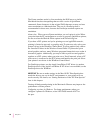
Using Macintosh peripheral devices in the PC environment
You use the serial ports of your Macintosh just like the serial ports of any
PC-compatible computer.
The maximum data transfer rate supported by the DOS-compatible hardware
when a COM port is mapped to a Macintosh serial port is 19,200 bits per
second (bps). If you’re capturing serial output to a Mac OS text file, there is
no limit.
For more information about serial ports, see “Configuring the PC Serial
Ports” in Chapter 6.
Using printers
For DOS or Windows printing, use the LPT1.DOS or LPT1 serial port. In
general, you must use printers that are Macintosh-compatible, and you must
use their corresponding Macintosh printer extensions. However, in a PC
Novell NetWare environment you can print to a PC-compatible printer
attached to a Novell network. See Appendix E, “Installing Network
Management Software.”
DOS uses the printer selected in the Macintosh Chooser as the default LPT1
device. If you have a serial printer directly connected to a COM port,
however, DOS uses that printer instead.
The DOS-compatible software can process output for Epson and PostScript
™
printers, and for all printers that use Hewlett-Packard’s page control
language (PCL).
If a printer is not a PostScript or PCL printer, it’s considered to be a
QuickDraw printer. QuickDraw printers such as the Apple StyleWriter or
ImageWriter work only with Epson emulation. For non-PostScript PCL
printers, use the appropriate PCL driver in the PC environment. For non-
PostScript, non-PCL printers, configure your DOS application program to use
the Epson LQ-2500 driver. If this driver isn’t available, try another Epson LQ
or LX series driver. Be sure to turn on the PCL option if it’s available for
your printer.
57
Operating in the PC Environment


















